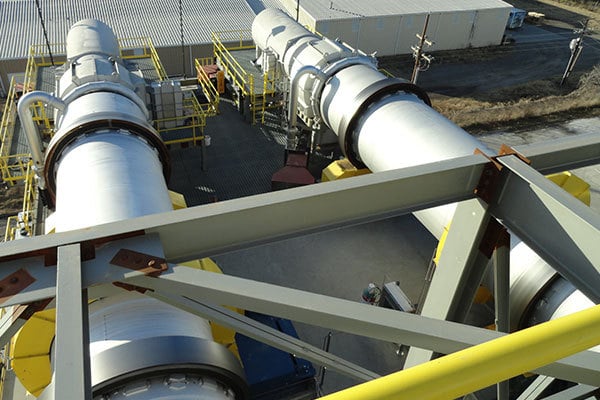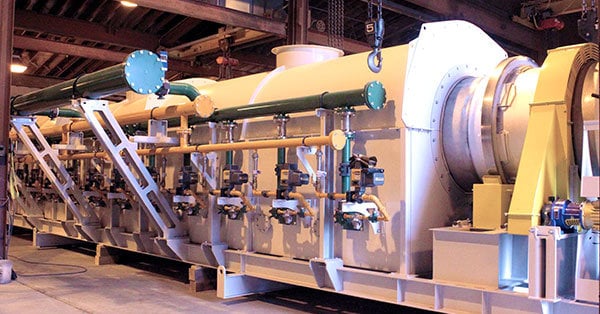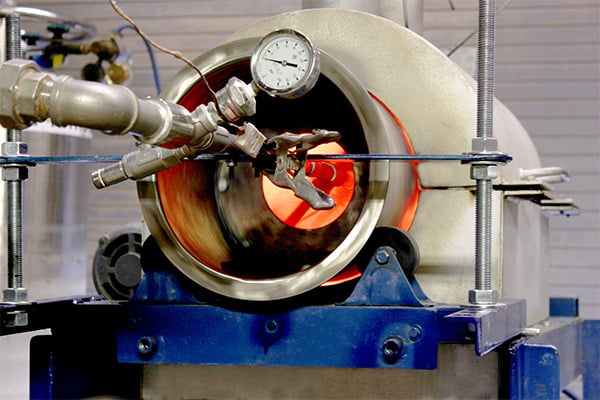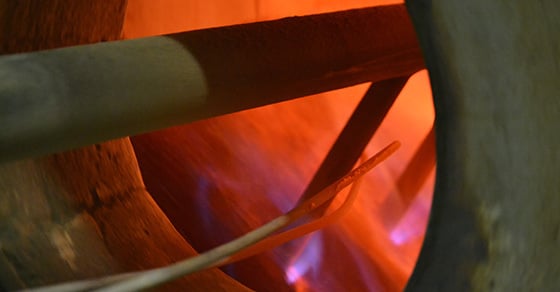Calcination is the process of heating a solid material in order to cause chemical separation of its components. The diversity of chemical separation lends calcination to accomplishing a range of objectives, from the removal of chemically bound (crystalline) water, to the volatilization of contaminants from a source material, thermal decomposition, and even phase changes. Each of these objectives in turn lends to a wide array of industry and material applications and process goals.
Calcination gives industrial producers a tool to control end product characteristics, minimize contamination in waste materials or process by-products, and so much more. As such, calcination has become an essential treatment in industrial process settings, and the rotary calciner a cornerstone of the process.
Note: It’s important to recognize that the term “calcination” is often used interchangeably with other thermal treatment processes, despite not meeting the technical definition of a true calcination process. This has resulted in significant confusion around the process and blanket use of the term.
A Deeper Look at the Calcination Process
Calcination centers around heating a material to a predetermined temperature, for a predetermined amount of time, in a controlled atmosphere. True calcination occurs when material is brought to a temperature at which one or more components chemically separate into more basic building blocks. This often results in the oxidation of a target component, removal of a volatile component or organic matter, chemical dehydration, and/or the decomposition of carbonates.
Since the term is so broadly applied, however, in some cases it may be used to refer to other thermal processes such as reduction, induration, heat setting, and more.
When a material has undergone calcination, it is often referred to as “calcine,” no matter its origin or makeup.
Important Parameters in Calcination
The calcination process is flexible in that various process parameters can be manipulated to control the reaction(s) and fine-tune end product characteristics. The most influential parameters are summarized here.
Temperature Profile
Both process and material temperature are carefully measured and controlled during calcination. In many cases, the temperature is controlled for rapid or gradual increase, holding material at a given temperature for a specific amount of time, and/or rapid or gradual cooling.
Temperature control is managed through the controls system of the calciner, with sensors inside the unit providing data to the operator.
Retention Time
The retention or residence time ties in closely with the temperature requirements, as the material often requires holding at temperature to achieve the desired reaction. Retention time is controlled through drum speed, slope, size, and if necessary, dams.
Atmospheric Conditions
The atmospheric conditions inside the calciner provide the processing environment necessary to carry out the intended reaction. This typically requires careful control over the amount of oxygen in the kiln, and in some cases may necessitate the introduction of an inert gas to facilitate or maximize the efficiency of the reaction.
Rotary Calciners (Kilns)
Various types of equipment are available for carrying out the calcining process, with rotary kilns being one of the most commonly employed types.
Calcination can be carried out in either a direct-fired or indirect-fired rotary kiln, both often referred to as calciners in this setting.
Direct-Fired Rotary Calciners
Direct-fired kilns use direct contact between the material and the products of combustion in order to heat the material. The material is fed into the rotating drum, along with the products of combustion. The material and products of combustion can move co-currently (parallel) or counter-currently to each other, depending on the process goals and material characteristics.

Two FEECO Direct-Fired Kilns (Calciners)
Indirect-Fired Rotary Calciners
While direct-fired kilns use direct contact between the material and products of combustion, indirect-fired kilns avoid contact between the material and the products of combustion. This allows for the processing environment to be tightly controlled or inert, and is ideal for materials that cannot come into contact with oxygen, or that require a specific atmosphere for the desired reaction to occur.
In this case, the drum’s interior is sealed off and heated from the outside. Instead of being heated through contact with the products of combustion, the material is heated through contact with the drum’s shell. This approach is much less efficient, but necessary for some materials and process goals.

FEECO Indirect-Fired Kiln/Calciner used for processing wood chips
Various internals can be used to customize either type of kiln in order to increase efficiency. This might include the addition of flights, dams, bed disturbers, and more.
Industry Examples of Calcination
Calcination is a common process, the most recognized example of which is the dissociation of calcium carbonate to create calcium oxide and carbon dioxide in the production of cement from limestone. Other applications of calcination include:
- Catalyst preparation
- Diatomaceous Earth processing
- Kaolin Clay processing
- Conversion of Spodumene to Lithium
- Production of Expanded Clay Aggregates
- Pigment production
- Production of Aluminum and Alumina
Depending on the material and the process goals, the calcination process is often used to control product qualities such as:
- Brightness
- Purity
- Porosity and/or surface area
- Pore structure
- Refractive index
- Chemical stability
- Friability
- Inertness
- Ansorptive capacity
- Chemical phase
- Color
- Density
- Abrasivity
- Opacity
- And more…
Developing an Effective Calcination Process
The many objectives of calcination, paired with the range of materials, their unique characteristics, and the various end product goals, makes testing an important part of developing an effective and efficient calcination process for a given application.
The FEECO Innovation Center offers several batch- and pilot-scale test kilns (both direct and indirect) for testing development work, including showing proof of concept, proof of product, and proof of process. The testing process also gives producers the opportunity to gather critical process data around their material for scale-up and design of a commercial-scale calciner, including:
- Gas sampling & analysis
- Pretreatment requirements
- Process parameters
- Burner fuel usage
- Calciner sizing
- Emissions

Calcination testing in a batch calciner in the FEECO Innovation Center
Conclusion
Calcination is a diverse thermal treatment in which the chemical separation of components gives producers the ability to remove volatile components, enhance product characteristics, remove crystalline water, and more. Temperature, retention time, and processing atmosphere are important factors in calcination and are often developed through testing.
FEECO engineers and manufactures the industry’s best custom rotary calciners. And with a well-equipped testing facility, producers can be sure their calcination process will perform efficiently and reliably. For more information on our calciners or testing capabilities, contact us today!


